Living with asthma goes far beyond just taking daily medications or relying on inhalers—it’s also about shaping your surroundings to make breathing easier every single day. For most people, the home is a safe space, but for those with asthma, it can often hide triggers that silently aggravate symptoms.
The air inside your home can be filled with more irritants than expected. From microscopic dust mites and lingering pet dander to mold growth and harsh chemical cleaning agents, poor indoor air quality can sneakily worsen asthma symptoms. The key is awareness—and taking control of your living space to reduce those everyday triggers.
The good news? You don’t have to overhaul your lifestyle completely. With just a few thoughtful adjustments, you can create a home that’s more asthma-friendly, more breathable, and more comfortable for you and your loved ones.
In this guide, we’ll walk you through simple, practical tips for each area of your home—from bedrooms and kitchens to bathrooms and beyond. Whether you’re newly diagnosed or looking to fine-tune your asthma management, these room-by-room strategies will help you breathe a little easier, one space at a time.
Entryway: Your First Line of Defense
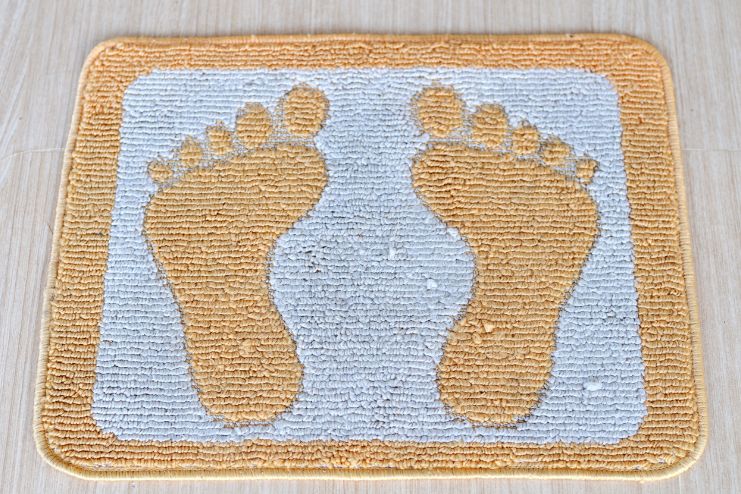
Your entryway might seem like an afterthought, but it’s your home’s front line when it comes to keeping allergens and pollutants out. Think of it as a filter—whatever enters your home usually passes through here first.
So, let’s make it work in your favor.
Trap Outdoor Allergens Early
A clean, well-maintained space can prevent pollen, dust, and other triggers from entering your home.
- Use Doormats: Place sturdy doormats outside and inside the entrance to catch pollen, dirt, and dust.
- No-Shoe Policy: Encourage family members and guests to remove their shoes at the door. Shoes track in pollen, mold, and other irritants.
- Designate Storage: Store shoes, coats, and bags away from the main living area to prevent allergen spread.
- Ventilation Counts: Keep the entryway ventilated to prevent stale air from circulating inward.
- Dust and Sweep Often: Clean the area at least twice a week—entryways accumulate more grime than you’d think.
Quick Habits That Help
- Clean door handles and switches regularly.
- Keep umbrellas and wet items dry to prevent mold near the door.
The entryway might be small, but it plays a big role in making your home asthma-safe from the moment you walk in.
Bedroom: Create a Sanctuary for Restful Sleep
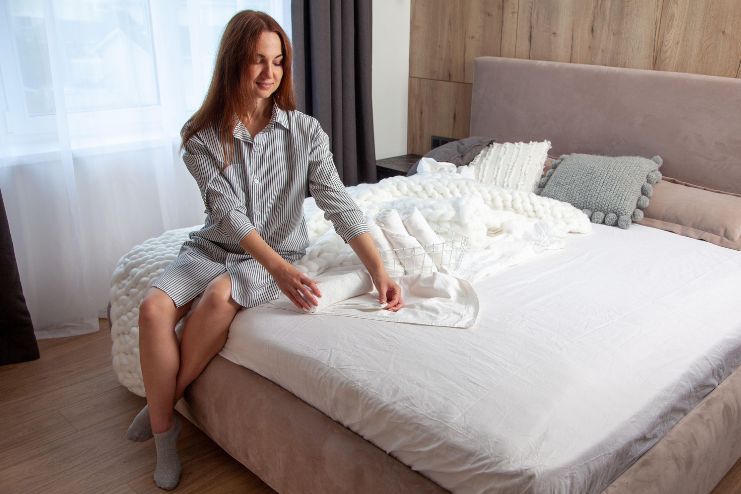
The bedroom is where you unwind, rest, and recover, which is exactly why it should be one of the cleanest, calmest, and most asthma-friendly spaces in your home. Since we spend almost a third of our lives sleeping, poor air quality here can quietly worsen asthma symptoms, disrupt sleep, and lead to flare-ups overnight.
Thankfully, with a few mindful adjustments, your bedroom can be transformed into a true sanctuary that supports both your lungs and your lifestyle.
Minimize Allergens & Irritants
The first goal is to reduce common triggers like dust mites, pet dander, mold, and pollen, many of which hide in plain sight.
- Hypoallergenic Bedding: Use dust-mite-proof covers on pillows, mattresses, and box springs.
- Pet-Free Zone: As adorable as pets are, it’s best to keep them out of the bedroom—or at least off the bed—to avoid breathing in dander while you sleep.
- Carpet Considerations: If you have carpet, vacuum it regularly using a HEPA filter vacuum. If you’re considering renovations, replace carpets with hard flooring like laminate or tile—easier to clean and less likely to trap allergens.
- Air Purifier with HEPA Filter: One of the best investments for asthma care. It helps filter out fine dust, pet dander, pollen, and even mold spores.
- Maintain Proper Humidity: Use a dehumidifier to keep humidity between 30% and 60% to prevent mold and mildew growth.
- Avoid Harsh Chemicals: Choose fragrance-free, low-VOC (volatile organic compound) cleaners to reduce chemical irritants that may linger in the air or on surfaces.
According to Dr. Purvi Parikh, allergist and immunologist, Allergy & Asthma Network, NYU Langone, “Dust mites are one of the most common triggers of allergic asthma, and they thrive in bedding, pillows, and mattresses. I always recommend patients use allergen-proof covers and wash bedding in hot water weekly.”
Quick Habits That Go a Long Way
- Change sheets weekly, and vacuum the floor and upholstery regularly.
- Never allow smoking in or near the bedroom—it’s one of the most aggressive asthma triggers.
- Consider calming houseplants like snake plants or peace lilies that help purify air, but check for mold-prone soil and overwatering.
Your bedroom should do more than just offer sleep—it should support your breathing, comfort, and overall well-being. With a few smart tweaks and habits, it can become the restful, low-trigger zone your lungs truly deserve.
Living Room: Keep Shared Spaces Clean and Allergen-Free
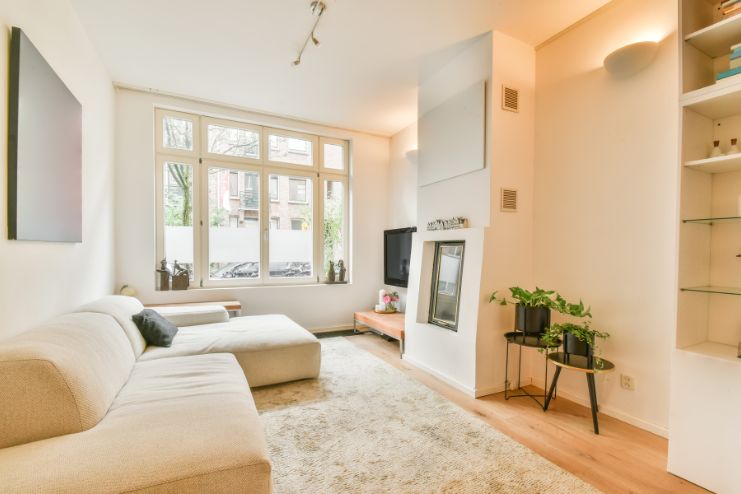
The living room is where we relax, entertain, and spend time with family, but it can collect more dust, dander, and other allergens than we realize. From upholstered furniture to electronic gadgets, almost everything in your lounge space can affect indoor air quality.
Making it asthma-friendly doesn’t mean giving up on comfort—it just means being a little more mindful.
Tackling Dust and Dander
This cozy space collects a surprising amount of dust, pet dander, and allergens, especially in fabrics and soft furnishings.
- Choose the Right Furniture: Opt for leather or tightly woven fabric over plush or shaggy upholstery that traps dust.
- Declutter Surfaces: Keep shelves, coffee tables, and display units minimal to reduce dust buildup.
- Vacuum Regularly: Use a vacuum with a HEPA filter and do it at least twice a week. Don’t forget to clean under the couches and cushions.
- Curtains and Rugs: Wash curtains monthly and clean area rugs weekly, or consider removing them altogether.
- Avoid Smoke and Strong Scents: Candles, incense, and smoking indoors should be avoided entirely. Even “natural” scents can be irritating to sensitive lungs.
Quick Habits That Help
- Dust electronic devices regularly—they attract particles due to static.
- Keep windows closed on high-pollen days.
- Rotate and wash throw pillows and blankets.
When your living room is clear of triggers, it becomes a true place of rest for both your body and your breathing.
Kitchen: Control Moisture and Cooking Fumes

The kitchen is a surprising hotspot for asthma triggers. Cooking fumes, cleaning chemicals, and even pantry pests can create breathing issues if not managed well. Since it’s a space you use multiple times a day, it’s worth making sure it supports clean, healthy air.
Let’s make your kitchen as safe as it is delicious.
Keeping It Clean, Ventilated, & Fume-Free
Cooking fumes and strong cleaners can silently affect air quality. A few tweaks can make this space safer for your lungs.
- Use a Range Hood or Vent: Always turn on the exhaust fan or range hood while cooking, especially when frying or sautéing.
- Avoid Gas Stoves If Possible: Gas stoves can emit nitrogen dioxide, which may worsen asthma. If you use one, ensure proper ventilation.
- Cover Pots While Cooking: This helps reduce steam and airborne particles.
- Keep Surfaces Dry: Moisture from the sink and cooking can lead to mold—wipe spills quickly.
- Empty the Trash Daily: This reduces odor and moisture buildup that could affect air quality.
Quick Habits That Help
- Deep-clean the fridge and pantry monthly.
- Keep windows open while cooking, weather permitting.
- Clean the grease filters in your range hood regularly.
A fresh kitchen, ventilated and chemical-free, is the perfect recipe for healthy lungs.
Dr. John Balmes, Professor Emeritus of Environmental Health Sciences, University of California, says that “Gas stoves can release nitrogen dioxide, which is known to irritate the lungs. For people with asthma, using ventilation like an exhaust fan is essential while cooking.”
Bathroom: Prevent Mold and Manage Humidity
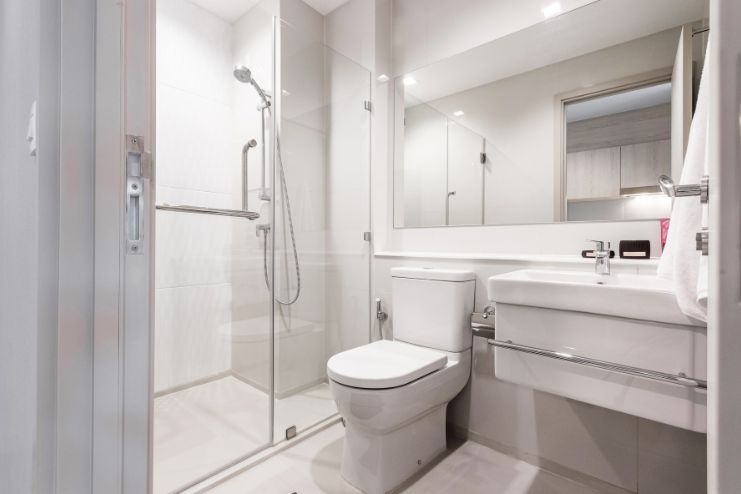
The bathroom might be the smallest room in your home, but it can be one of the biggest contributors to asthma triggers, especially when it comes to moisture and mold. Bathrooms are naturally humid, making them the perfect breeding ground for mold spores that can irritate the lungs and cause breathing difficulties.
But don’t worry—with the right habits and a little consistency, you can easily keep this space safe and refreshing.
Control Moisture & Prevent Mold
Humidity and poor ventilation can turn your bathroom into a mold magnet. Keeping it clean and dry helps keep asthma at bay.
- Proper Ventilation is Key: Always use an exhaust fan while showering and keep it running for at least 20 minutes afterward. No fan? Crack a window open to let steam out.
- Fix Leaks Immediately: Whether it’s a dripping faucet or water pooling around the tub, even minor leaks can promote mold.
- Dry Surfaces Promptly: Wipe down shower walls, tiles, and mirrors after use to reduce moisture buildup.
- Mold-Resistant Products: Opt for mold-resistant paint and caulk when renovating.
- Avoid Scented Sprays: Air fresheners and scented cleaning products can contain VOCs that trigger asthma. Stick to natural or fragrance-free options.
Quick Habits That Help
- Hang towels to dry immediately to prevent mildew.
- Wash bathroom mats weekly.
- Keep the shower curtain clean and mold-free (or switch to a mold-resistant version).
A clean, dry bathroom isn’t just good hygiene—it’s a breath of fresh air for anyone living with asthma.
Dr. Payel Gupta, an Assistant Clinical Professor at SUNY Downstate Medical Center, states that “Remember, you can never truly purify the air, but you can clean it to a certain extent.”
Home Office or Workspace: Breathe Easy Where You Work

Your home office should inspire focus and productivity, but it should also support your health, especially if you spend hours a day there. Poor air circulation, dust buildup, and even the materials in your furniture can silently affect asthma symptoms.
Here’s how to turn your workspace into a wellness space.
Reduce Dust and Improve Hygiene
Whether you’re working from home or studying, a healthy workspace supports both productivity and asthma management.
- Declutter Desks: Keep only what you need on your desk to reduce surfaces where dust can settle.
- Wipe Down Regularly: Clean electronics, desks, and windowsills with a damp cloth weekly.
- Use a Desk-Side Air Purifier: Especially helpful if the room is small or lacks good ventilation.
- Choose Non-Toxic Supplies: Stationery, markers, or adhesives can contain VOCs. Choose non-toxic alternatives when available.
Quick Habits That Help
- Store papers and files in drawers or boxes.
- Set a reminder to get up and stretch near a window every hour.
A clean, calm office equals sharper focus and easier breathing. Sounds like a win-win, right?
Hallways & Common Areas: Small Spaces, Big Impact
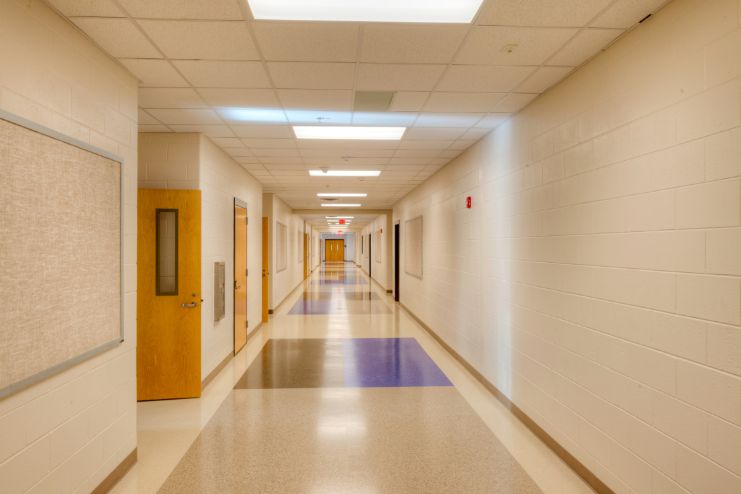
They may not be the most glamorous spots in your home, but hallways, staircases, and entryways play a big role in your home’s overall air quality. Thanks to high foot traffic, these zones tend to collect dust, dirt, pollen, and pet dander—all of which can be easily overlooked in your cleaning routine.
But a little attention here can go a long way in minimizing everyday asthma triggers.
Keep the Floors Clean
These high-traffic zones are often overlooked, but they’re prone to dust buildup and can spread allergens throughout your home.
- Vacuum Regularly: These areas see a lot of movement, so vacuuming two to three times a week—especially with a HEPA filter—helps prevent allergen buildup.
- Wipe Down Hard Surfaces: Banisters, baseboards, and door frames can collect dust—give them a wipe with a damp microfiber cloth weekly.
- Remove Clutter: Hallways with shelves, shoe racks, or hanging coats can gather dust and trap allergens. Keep it simple and easy to clean.
Quick Habits That Help
- Store coats, bags, and shoes in a closed closet or a designated bin to avoid spreading particles.
- Sweep or vacuum under furniture placed in common areas at least once a week.
It might feel like a small step, but giving your hallways some love keeps the rest of your home breathing easier.
Outdoor Spaces: Manage Pollen and External Triggers

Asthma management isn’t just about what’s inside—it starts before you even walk through the front door. Outdoor spaces, from balconies and patios to backyards and garden paths, can be beautiful and relaxing… or full of pollen and pollutants waiting to hitch a ride inside.
With a few conscious choices, your outdoor environment can become a healthier extension of your home.
Be Smart About Landscaping
Outdoor allergens like pollen and pollution can sneak inside. Managing your outside space is just as important as managing your indoor space.
- Choose Allergy-Friendly Plants: Some plants, like lavender and ferns, are less likely to trigger allergies. Avoid high-pollen trees like birch, oak, and ragweed.
- Maintain Your Yard: Regularly mow the lawn, remove weeds, and rake leaves to prevent pollen and mold buildup.
- Avoid Peak Pollen Hours: Early morning and windy days often have higher pollen levels. Plan gardening or outdoor play accordingly.
- Keep Outdoor Gear Separate: Store garden gloves, shoes, and jackets outside or in a designated entry space.
- Shower After Outdoor Time: This helps remove pollen from your skin and hair, especially during allergy season.
- Close Windows on High-Pollen Days: As tempting as a breeze can be, check pollen counts before letting outdoor air in.
Quick Habits That Help
- Check the local pollen forecast before planning outdoor activities.
- Wear a mask while gardening or mowing.
- Use a hose to rinse off patios and outdoor furniture occasionally.
Your home’s first line of defense starts outside, so the cleaner and calmer your outdoor areas are, the better your indoor air will be.
Kids’ Room: Safe, Simple, and Sweet
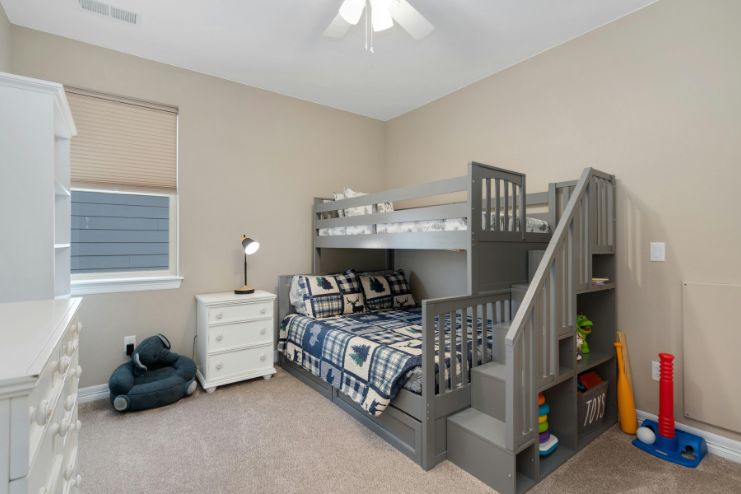
Your child’s bedroom should be a haven where they can rest, play, and grow, without worrying about asthma flare-ups. But toys, soft furnishings, and clutter can easily trap allergens and dust if left unchecked.
Luckily, with a few small tweaks, you can keep their space cozy and clear.
Keep It Clean and Clutter-Free
Children’s lungs are still developing, and their rooms should be free from asthma triggers like dust, VOCs, and mold.
- Limit Stuffed Toys: Soft toys can collect dust mites. Choose washable ones.
- Go Minimal: Avoid overcrowding the room with plush furniture, rugs, and heavy curtains.
- Storage Bins: Use closed bins for toys to keep dust out and make cleaning easier.
- Air Purifier: A HEPA air purifier can help maintain clean air in your child’s room.
Quick Habits That Help
- Wash bedding and soft toys weekly in hot water.
- Use dust-mite-proof covers for pillows and mattresses.
- Avoid using scented products like plug-in fresheners.
With a few mindful adjustments, your child’s room can become a breath-easy zone where they feel safe and sleep soundly.
Here is a Quick Glimpse to Deal with Asthma Triggers
Short on time? No worries—we’ve got you covered. This quick video by AAFA National breaks down the most important tips from the guide in under a few minutes. Whether you’re just getting started or need a refresher, hit play for a fast, visual walkthrough on keeping asthma triggers under control at home.

Everyday Habits That Make a Big Difference
Sometimes, it’s not the big changes but the quiet, consistent habits that protect your lungs the most. These easy routines help reduce asthma triggers without disrupting your lifestyle. By making them second nature, you’re keeping your home fresher, cleaner, and safer—day in, day out.
Here’s how to quietly level up your asthma-safe environment.
- Keep closet doors slightly open to avoid musty air buildup.
- Wipe down window sills and baseboards—they collect surprising amounts of dust.
- Rotate and air out mattresses every few months to prevent allergen buildup.
- Run a dehumidifier during showers or dishwashing if humidity spikes.
- Use microfiber cloths for dusting—they trap allergens better than regular rags.
- Set reminders to check for mold in overlooked spots like behind appliances or under sinks.
- Air out storage spaces and attics seasonally—they often harbor stale air and hidden triggers.
READ MORE: 10 Common Triggers That Could Worsen Your Asthma
Wrapping It Up: Breathe Easier, Live Better
Creating an asthma-friendly home isn’t about chasing perfection—it’s about building habits that help you (or your loved ones) breathe a little easier every single day. From the obvious hotspots like the bedroom and kitchen to the often-overlooked areas like hallways and entryways, every space plays a role in your home’s air quality and comfort. And the best part? Most changes are simple, affordable, and doable with a little intention.
You don’t need to overhaul your entire house overnight. Start small—maybe with a good HEPA purifier in the bedroom or switching to fragrance-free cleaners in the kitchen. As these shifts become part of your routine, you’ll start noticing the difference not just in breathing but in how your entire home feels: fresher, lighter, and more peaceful.
At the end of the day, a home should be your safest space, especially for your lungs. So here’s to clearer air, fewer flare-ups, and a healthier, happier space you can truly relax in. You’ve got this, one room at a time.
References
- https://www.tevauk.com/life-effects/asthma-proof-your-home/
- https://www.healthline.com/health/asthma/asthma-friendly-home#1
- https://aafa.org/allergies/prevent-allergies/healthier-home-indoor-air-quality/
- https://www.cdc.gov/asthma/control/
- https://aafa.org/asthma/asthma-triggers-causes/
- https://www.livescience.com/six-benefits-of-an-air-purifier
- https://www.betterhealth.vic.gov.au/health/conditionsandtreatments/asthma-friendly-home
- https://www.kingliving.com.au/blog/create-asthma-friendly-home
- https://www.prestigebeds.co.uk/2018/02/19/make-bedroom-asthma-friendly/
- https://community.aafa.org/blog/cleaning-when-you-have-asthma-the-dirty-truth
- https://asthma.net/living/bathroom-triggers
- https://www.lung.org/help-support/corporate-wellness/decrease-burden-of-asthma
- https://www.homesandgardens.com/solved/things-secretly-making-allergies-worse-at-home
- https://www.newyorker.com/magazine/2019/04/08/the-hidden-air-pollution-in-our-homes
In this Article





















